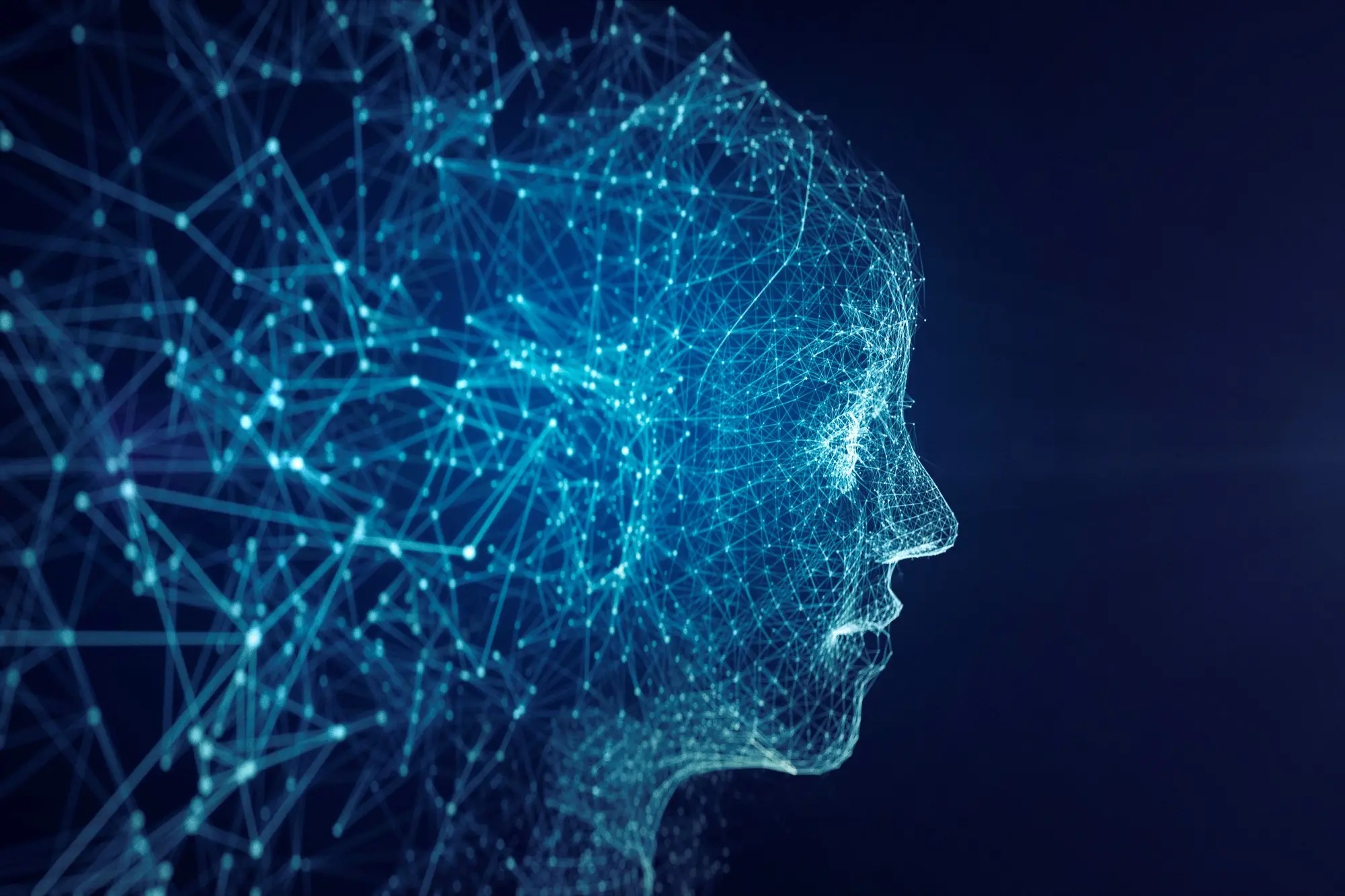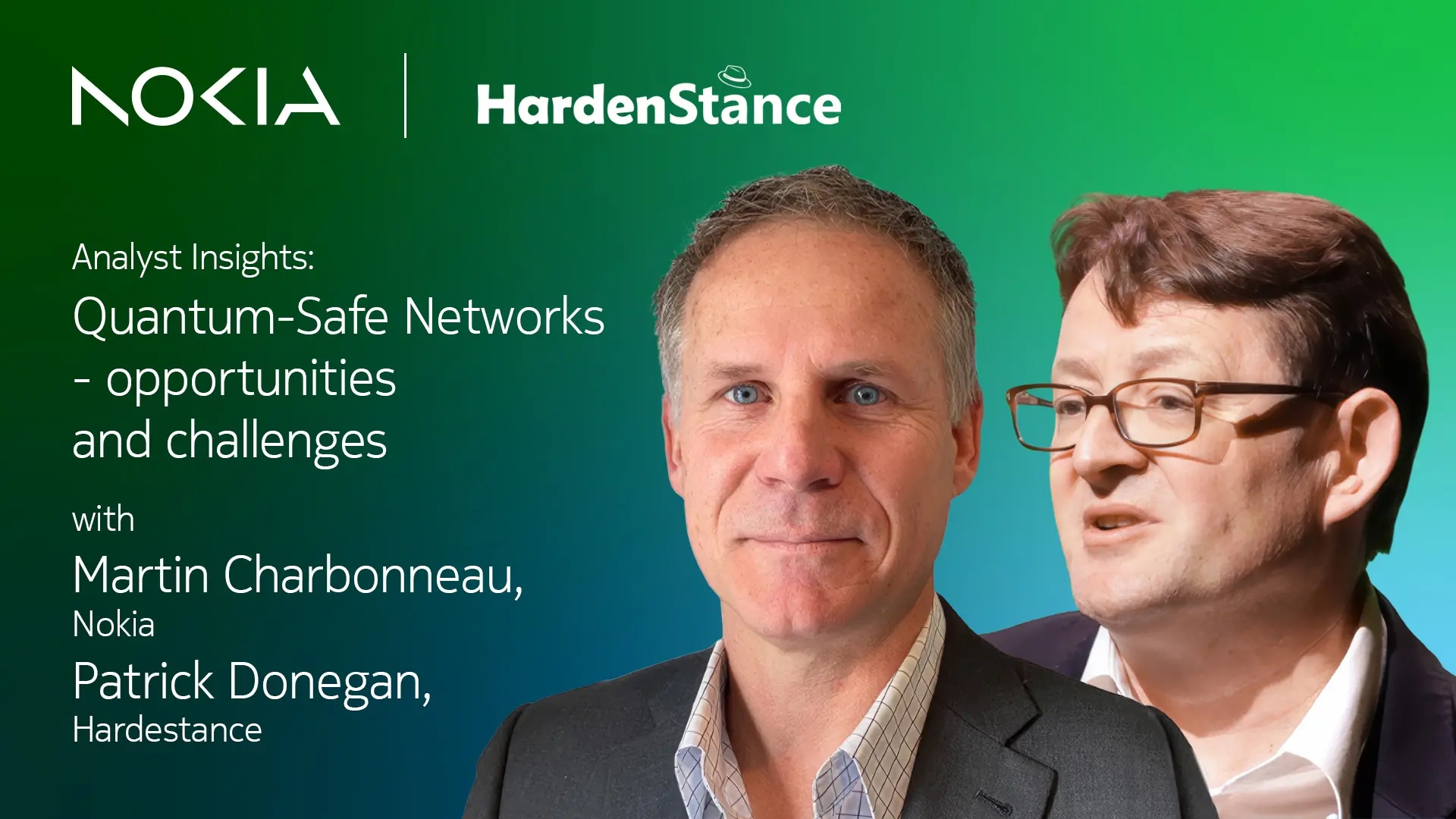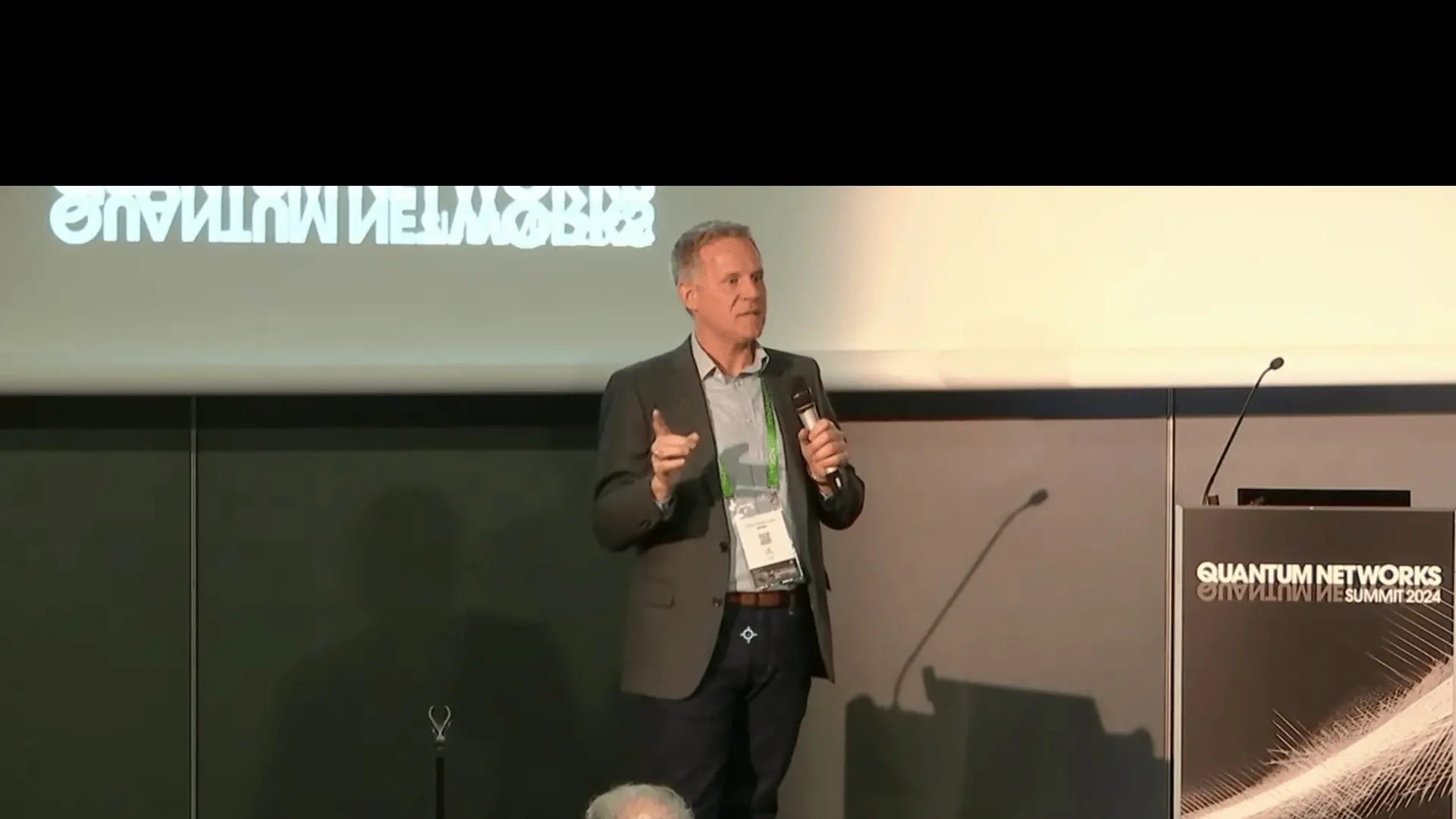Quantum-safe networks
Making critical infrastructure quantum-safe

Quantum computing will create limitless innovation potential for enterprises, governments, and society — but in the wrong hands, the power of quantum can create significant cyberthreats. The providers of the world’s critical infrastructure need to start preparing their networks now.
What is quantum computing?
Conventional computers are based on the concept that electrical signals can be in one of two states: on or off, which is traditionally expressed in ones and zeroes. These binary ones and zeros have powered everything from the earliest punch-card computers to today’s smart devices. But until now, there’s been a limit to how powerful computers can be.
Quantum computers are based on the principles of quantum mechanics, which allow for many states between on and off. They do not run on ones and zeroes, they run on electrons and photons. They are also not limited to one state at a time. This means they can perform tasks exponentially faster than binary computers and can also carry out multiple processes at once, further increasing their capacity and speed. Quantum computers can solve problems or break data encryptions in mere minutes that would have taken even the biggest conventional supercomputers thousands of years to compute.
How can critical infrastructure industries and governments benefit from quantum computing?
- Power utilities and transportation networks can better predict weather, track demand patterns and compute their effect on capacity demands
- Defense operations can use quantum sensing and analytics to improve reconnaissance, surveillance and deep-sea navigation
- Public safety can benefit from more advance notice of climate events and better model risk scenarios
- Research and Education Networks (RENs) can make complex calculations that were previously impossible, accelerating key breakthroughs
- In the Mining and natural resources industry, companies can more accurately determine the best places to drill for key resources with the least environmental impact
- Financial services and market analyst organizations can better model trends and model investment data
- Telecommunications can benefit from advanced network and traffic modeling to better serve their customers
Trending topics
Why is quantum computing a cybersecurity concern?
Today’s encryption mechanisms have historically been sufficient to protect in-flight network data and provide digital signatures for our digital economy. Encryption uses highly complex mathematical techniques to “hide” the data, with decryption performed using a randomly generated numerical key that is sent alongside the data. Because it would take thousands of years to try every possible key combination, conventional computers can’t brute force their way past encryption within any sort of useful timeframe. Quantum computing is a cybersecurity concern because that all changes with quantum computing, which enables threat actors to brute force through even the toughest protocols.
But that will require a cryptographically relevant quantum computer (CRQC). A CRQC is a quantum computer powerful enough and equipped with the software necessary to break the cipher keys used in encryption. While a CRQC does not exist just yet, it’s only a matter of time until one gets developed. That moment is called “Q-Day” — and most experts think it will arrive around 2030.
But the risks starts before Q-Day. Threat actors can “harvest” encrypted data today, even if they can’t do anything with it. They can simply hold onto it until they can decrypt it with a CRQC in the near future. These are often called harvest now and decrypt later (HNDL) attacks.
What critical infrastructure industries could be impacted by a quantum-fueled cyber attack?
The potential for disaster when Q-Day comes is considerable. With today’s public key cryptography rendered useless, rendered useless, all networks — across all industries — will become vulnerable to attack. Malicious actors could cripple critical infrastructure by attacking the networks that support them. Quantum threats could impact power and water supplies, public transportation systems, telecommunications, public safety communications, defense IT infrastructure, financial market data and systems, healthcare research and hospital networks, and more – with life-threatening and economy-impacting consequences.
Quantum attacks won’t target only those companies or organizations that are using quantum computers themselves. A CRQC poses a threat to any industry, as well as the businesses and individuals they serve.
Are modernized networks more vulnerable to quantum-fueled cyber attacks?
Critical industries and service providers are accelerating the digitalization of their operations and in turn are reaping the benefits of business agility and continuity, productivity efficiencies, and sustainability. As organizations see convergence of OT and IT systems or move from manual to digital systems, adding complexity or distributed network functions, they also increase the potential attack surface for malicious actors.
So what do we do? Digitalization is how progress will happen; we can’t — and won’t — ‘put the genie back into the bottle’. Fortunately, modernized networks not only bring the benefits of digital innovation — future-forward solutions also carry with them inherently robust defense-in-depth mechanisms that protect against the cybersecurity threats of today and tomorrow.
Critical infrastructure and service providers don’t have to wait. They can begin choosing quantum-safe networking technology as they architect their digital transformation and move their foundational networks to modernized technologies that adopt a defense-in-depth, quantum-safe network approach.
What are quantum-safe networks?
Quantum-safe networks are designed to be secure and trusted even against attacks from the threats posed by Cryptographically Relevant Quantum Computers (CRQC). Quantum-safe networks use quantum-safe cryptography that are secure even in the presence of powerful quantum computers.
Key ingredients of Quantum-Safe Networks are:
- Cryptographic Keys
- Key distribution
- Network encryption
Quantum-safe cryptographic keys should support the application of both classical and quantum physics, as well mathematical Post-Quantum Cryptography (PQC) keys once they are available.
The Quantum-safe cryptographic keys can be distributed using:
Symmetric centralized key distribution (SCKD) is a way of sending decryption keys separately from encrypted data, making it harder for threat actors to acquire both pieces required to access the data. This technology is available right now and has been in use for several years.
Quantum keys, transmitted through a quantum key distribution (QKD) network, are now in development. Using the physical properties of photons rather than math problems for encryption, it becomes possible to detect the presence of any third party trying to intercept the key — for an additional layer of security against quantum hacking.
Public Key Cryptography (PKC) with evolution of Public Key Infrastructures (PKI) with the availability of the mathematical Post Quantum Cryptography (PQC) keys.
A quantum-safe ecosystem will include all three of these approaches, matched with the appropriate Quantum-Safe network encryption, as well as other technologies as the quantum landscape evolves.
What can I do to protect my network today from quantum threats?
Addressing quantum network threats demands a comprehensive strategy. We deliver the key ingredients of quantum-safe networks to deliver quantum-safe cryptographic network solutions today.
Nokia Quantum-Safe Networks (QSN) has a defense-in-depth approach that delivers quantum-safe security at multiple layers through multi-layered cryptography. Nokia QSN can adapt to your business and use case needs; deliver you the confidence to securely scale your Quantum deployments in response to the Quantum threat; and can evolve with the quantum landscape.
We can deploy quantum-safe cryptographic keys, by strategically applying both classical and quantum physics, as well mathematical Post-Quantum Cryptography (PQC) cryptographic keys once they are available.
We support a range of key distribution options, including automated key generation, distribution, and orchestration through the 1830 SMS platform. This delivers scalability, accelerates service fulfillment, increased resiliency, while also reducing operational workloads, and errors.
This is complemented by a range of network cryptography solutions, secured with AES-256 network encryption, at the OTN, Ethernet, MPLS and IP network layers providing the adaptability to meet a range of business requirements.
With our defense-in-depth approach, not all layers necessarily need cryptography. What is needed is the application of cryptography with a complementary and additive approach at one or more layers, depending on your business requirements and network operational model.
Our adaptability to implement cryptography as required at one or more of the Optical, Ethernet, MPLS and IP layers, delivers defense in-depth for redundant and complimentary security measures, enhancing the overall resilience of the network infrastructure, even in the face of evolving quantum threats.
Concurrently, Nokia Bell Labs is at the forefront of leading-edge research in specific technological domains, driving innovation with key academic and technology partners and shaping the future of quantum-safe network solutions.
Nokia is global leader with Quantum-Safe Network solutions available today, and we can help you navigate and evolve with the quantum landscape.
What will the future bring?
We are moving to what the World Economic Forum (WEF) is calling the Quantum Economy, and communications will be heavily influenced by 6G technologies which could significantly expand and augment human potential. But to get there, we will need to adapt to the changing business needs, continue to scale our networks, with an evolving threat landscape all while requiring greater security and trust from our networks than we do today.
Dive deeper into quantum security
See and hear about potential threats to critical networks and how to start your quantum-safe journey.

Article
Are you ready for Q-Day
Explore Nokia’s quantum-safe networking solutions
Quantum-safe networks will be needed to help protect critical infrastructure across industries and service providers. As a trusted partner, Nokia’s fast, reliable, and secure networking solutions can help you boost your organization’s security, resilience, agility, and efficiency.
A closer look at IP and Optical Networks Quantum-security

IP network security
Protect your network with multi-layered embedded IP network security.

Quantum-safe optical networking
Protect data from intrusion and theft though quantum-safe encryption, key management and intrusion detection
Discover high-performance, resilient and secure solutions for your industry
Learn more

Blog
Enhancing critical networks’ cybersecurity with XDR

Blog
Technically certified partners align at Nokia TechSquad

Blog
Protecting Research and Education Networks from DDoS attack
Video
Secure optical transport with Nokia
Latest news
Contact a Nokia Quantum-safe Expert
Please complete the form below.
The form is loading, please wait...
Thank you. We have received your inquiry. Please continue browsing.












































